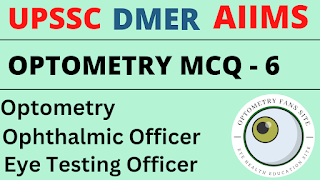Ophthalmic Officer / Optometrist MCQ Series Part - 6
◽1. In phacoemulsification incision is usually
• A. <3mm
• B. >3mm
• C. 6mm
• D. 10mm
◽2. Main cause of painless
progressive loss of vision in adults
• A. Cataract
• B. Open angle glaucoma
• C. ARMD
• D. Progressive myopia
◽3. Mydriatics are contraindicated if the anterior chamber is
• A. Deep
• B. Shallow
• C. Normal
• D. Irregular
◽4. Pachymetry is done in
• A. Glaucoma
• B. Fuch's distrophy
• C. Before LASIK
• D. All
◽5. Beta Blockers lower IOP mainly by
• A) Decreased aquous production.
• B) Increased aquous drainage
• C) Lower episcleral venous peressure
• D) All of above
◽6. Night blindness may occur in all except
• A. Vitamin A deficiency
• B. High myopia
• C. Angle closure glaucoma
• D. Oguchis disease
◽7. All the following are features of POAG except:
• A. Tubular vision
• B. Enlarged blind spot
• C. General depression of isopters
• D. Loss of central fields
◽8. Applanation tonometry is based on
• A. Imbert-Fick principle
• B. Goldman's equation
• C. Perkins principle
• D. Principle of indentation
◽9. Most accurate measurement of IOP is done using
• A. Digital tonometry
• B. Schiotz tonometry
• C. Pneumotonometry
• D. Applanation tonometry
◽10. Floaters can be seen in all of the following except ?
• A. Vitreous hemorrhage
• B. Retinal detachment
• C. Uveitis
• D. Acute congestive glaucoma
◽11. Retinal layer which is close to vitreous body
• A. Pigment epithelium
• B. External limiting membrane
• C. Internal limiting membrane
• D. Nerve fibres layer
◽12. Retinal layer which is close to choroid
• A. Pigment epithelium0
• B. External limiting membrane
• C. Internal
• D. Nerve fibres layer
◽13. In retinal detachment, fluid accumulate between
• A. Retina and choroid
• B. Pigment epithelium and rest of retina
• C. Internal limiting membrane and rest of
retina
• D. Outer nuclear layer and inner nuclear layer limiting membrane
◽14. The first order neurones of visual pathway consists
• A. Rods and cones
• B. Bipolar cells
• C. Ganglion cells
• D. Lateral geniculate body
◽15. Diameter of foveola
• A. 5.5 mm
• B. 1.5mm
• C. 0.35mm
• D. 0.1mm
◽16. Retina is thickest at
• A. Ora serrate
• B. Equatorial region
• C. Peripapillary region.
• D. Macular region
◽17. Retina is thinnest at
• A. Ora serrata.
• B. Fovea
• C. Foveola
• D. Macula
◽18. Most common cause of CRAO
• A. Embolism.
• B. Angiospasm
• C. Retinal arteritis
• D. Raised IOP
◽19. In CRAO, patient may
complaint
• A. Sudden painless loss of vision.
• B. Gradual painless loss of vision
• C. Sudden painful loss of vision
• D. None
◽20. Cherry red spot is seen in
• A. CRAO
• B. CRVO
• C. BRVO
• D. Diabetic retinopathy
◽21. Cattle truck appearance is seen in
• A. CRAO
• B. CRVO
• C. BRVO
• D. Diabetic retinopathy
◽22. Hard exudates are seen in
• A. Outer nuclear layer
• B. Outer plexiform layer
• C. Ganglion cell layer
• D. Nerve fibre layer
◽23. Cotton wool spots are seen in
• A. Outer nuclear layer
• B. Outer plexiform layer
• C. Ganglion cell layer
• D. Nerve fibre layer
◽24. In cystoid macular oedema, fluid accumulate in
• A. Outer nuclear layer
• B. Outer plexiform layer
• C. Ganglion cell layer
• D. Nerve fibre layer
◽25. Flame shaped haemorrhage occur in
• A. Outer nuclear layer
• B. Outer plexiform layer
• C. Ganglion cell layer
• D. Nerve fibre layer
Get Answer key 🔐 Require premium account
Or
Watch videos to Answer key 🗝️
Download Optometry MCQ Series - 11 PDF with Answer key Click below 👇 🔗
Tags:
Optometry MCQ Series

